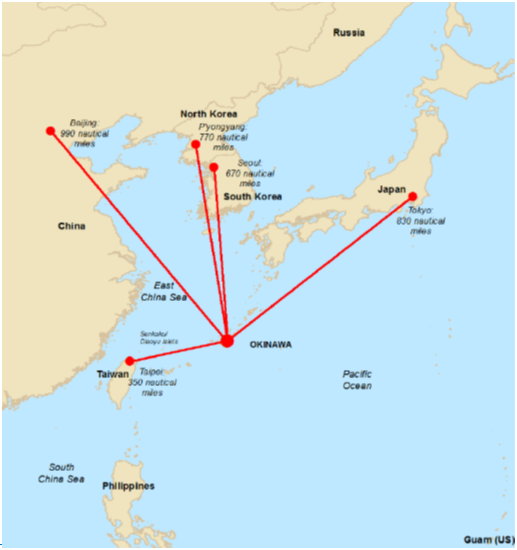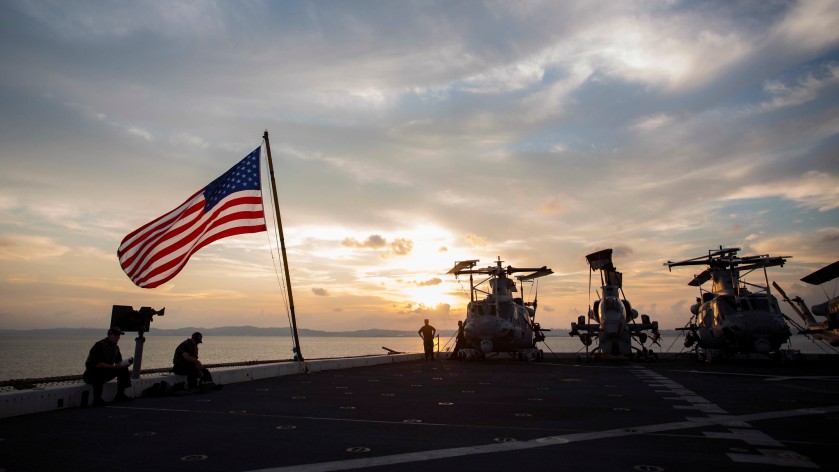Written by Mari Uchima.
Image credit: Old Glory by Marines/Flickr, license CC BY-NC 2.0
Most analyses of Taiwan’s security focus on cross-strait relations and the U.S.-China military balance. What is mostly missing in the debate is that the U.S. military bases in Okinawa, Japan, are critical to any U.S. defence of Taiwan due to their geographic proximity. Therefore, Taiwanese and analysts and students of Taiwan’s security should pay more attention to the ongoing developments there, as they have implications for Taiwan’s security.
From Taiwan’s perspective, the military and economic balance of power have more and more shifted in favour of the PRC in recent years, and the PRC has never renounced the use of force towards Taiwan, which its regards as an integral part of its territory. Hence, Taiwan depends more and more on the U.S. for its defence. The U.S. has held a stance of strategic ambiguity toward Taiwan since its Taiwan Relations Act came into law in 1979. When directly asked by Chinese officials in December 1995 what the U.S. would do if the PRC attacked Taiwan, Assistant Secretary of State Joseph Nye replied: “We don’t know and you don’t know. It would depend on the circumstances.” Strategic ambiguity serves to deter a PRC attack on Taiwan while discouraging Taiwan’s unilateral declaration of independence.
However, little attention has been given to the importance that Japan, specifically Okinawa, has for Taiwan’s security. In a hearing before the Committee on Foreign Relations of the U.S. Senate in August 1999, Richard Fisher Jr. — currently a Senior Fellow on Asian Military Affairs at the International Assessment and Strategy Center, a U.S.-based think tank — was quick to point out to U.S. military bases in Japan and Okinawa as “the likely redoubt of [U.S.] forces first to assist Taiwan” in case of a Chinese attack. In March 2010, Brookings Senior Fellow and CNAPS Director Richard C. Bush, during a presentation in Washington, remarked that the U.S. Marines and the U.S. Air Force on Okinawa “serve to strengthen deterrence” regarding possible Chinese aggression against Taiwan. According to him, China will be less likely to launch an attack because the U.S. has both ground troops and an airbase there. Should China attack U.S. installations on Okinawa, that would “almost” ensure a serious conflict. Therefore, the bases function as “a tripwire.” Furthermore, Japanese scholar Yasuhiro Matsuda from the University of Tokyo noted in 2018 that Japan “does play a substantial role in the security of Taiwan” as the U.S. cannot come to defend Taiwan without Japan’s support in case of Chinese aggression. In his words, “the risks and costs of China’s use of force increase greatly so long as Beijing believes that such an action might lead to a multi-front battle not only with the United States but also with Japan.”
Importantly, according to a RAND report published in December 2020, “Japanese officials understand that the United States will need to rely on bases in Japan to execute an operation in the region, such as the defence of Taiwan”. Meanwhile, per Article 6 of the U.S.-Japan Treaty of Mutual Cooperation and Security of 1960, the U.S. is legally obliged to consult with Japan before the launch of operations from its Japanese bases that serve any other purpose than defending. This means that should an armed conflict erupt over Taiwan and the U.S. decides to intervene utilising its Okinawa bases, it will need to consult with Japan and get its prior permission. The rationale for this stipulation is as follows: “If an action taken by the United States puts Japan in a position where it becomes a target, it needs to be consulted because these actions will affect Japanese security.” It is theoretically possible that Japan could deny the U.S. the right to use its Japan bases in a Taiwan contingency, but highly unlikely as that would call the whole alliance into question. For the same reason, it is unlikely that the U.S. launches operations from its Japan bases without first consulting Japan.
Today, Japan hosts a total of about 54,000 U.S. troops. According to figures provided by Okinawa’s prefectural government, Okinawa hosted 25,843 U.S. troops as of June 2011, the vast majority with 15,365 being Marines, followed by 6,772 Air Force personnel, 2,159 Navy personnel and 1,547 Ground Force personnel. In 2013, there were about 18,000 Marines and about 10,000 Air Force personnel in Okinawa. Furthermore, today, 70,4% of the land area used exclusively for U.S. military facilities in Japan is located in Okinawa Prefecture, which compromises only 0,6% of the Japanese land area.
Japan has provided bases to the U.S. since the 1952 U.S.-Japan security treaty, which was revised in 1960. Japan is constitutionally bound by Article 9 of its 1947 constitution. It renounced “war as a sovereign right of the nation” and the possession of land, sea, air forces, and other war potentials. Therefore, the so-called Japanese Self-Defence Forces (SDF) can only exert individual, and collective self-defence, which is, per definition, limited to the U.S. or other states in a close relationship to Japan under the 2015 security law passed under the Shinzō Abe government. This means that the SDF can only use the minimal force necessary to defend Japan and offer limited support to the U.S. or another state in a close relationship with Japan if attacked. The U.S. bases serve defending Japan and safeguard America’s interests in the Far East, including peace and stability in the region. A look on the map underscores Okinawa’s strategic importance: It shows Okinawa’s proximity to Taiwan, which makes it critical to the defence of Taiwan:

The U.S. military presence in Okinawa has not been without problems. In 1995, the rape of a 12-year-old Okinawan schoolgirl by three U.S. Marines sparked the most massive Okinawan protests against the U.S. military presence since Okinawa’s reversion to Japanese administration in 1972 and caused a crisis in U.S.-Japanese relations. Hence, the U.S. decided in April 1996 to return the Marine Corps Air Station Futenma to Okinawa to safeguard the people’s willingness to tolerate the U.S. military bases in the future. This was linked to the condition that an adequate replacement facility is built. This endeavour proved difficult, and negotiations took nearly two decades. In 2003, then-U.S. Secretary of Defence Donald Rumsfeld famously flew over MCAS Futenma, looked down, and declared it to be “the most dangerous base in the world.” It is located in the middle of the densely populated Okinawan city Ginowan and surrounded by residential areas and schools.
Japan’s central government finally began in December 2018, filling the coast off Henoko in northern Okinawa with gravel and insisted that the current plan to construct a new base in Henoko as a replacement facility was the “sole solution” to eliminate the dangers of Futenma Air Station. However, in a prefectural referendum held in Okinawa in February 2019, 71,7% of Okinawans voted against the land reclamation work at Henoko. This referendum is not legally binding. Furthermore, a Bankoku Shinryō Council report, summoned by current Okinawa governor Denny Tamaki of March 2020, concluded that the Japanese government should not continue construction at Henoko. Instead, it should consider alternative plans given the soft and unstable seabed discovered at the construction site. It estimates that the relocation to Henoko would take an additional 12 years after efforts to improve the ground quality have commenced. The Council also points out China’s improved capabilities to launch precision-guided missile attacks in recent years and contends that “the necessity of large permanent military bases is declining due to their military vulnerability.” It finds that “a new base in Henoko with an area of about 160 hectares and runways that are approximately 1800 meters in length may be too large for promoting dispersed operations and too small to serve as a support base during a military contingency.” Therefore, it concludes that “the base construction plan is not the best option from a military point of view.”
As this article has demonstrated, the U.S. bases in Japan, more specifically Okinawa, are critical to any U.S. defence of Taiwan. Therefore, the ongoing developments there, including the Futenma relocation issue, are worth to be observed closely from the perspective of Taiwan’s security. Knowing the United States’ capabilities there and how the base relocation will impact them is crucial. How the U.S. would react to a Taiwan contingency, of course, remains unclear. Knowing these capabilities clarifies how the U.S. could react in such a case and is thus something worthwhile to pursue.
Mari Uchima is a German-Japanese Master’s student in Stanford’s East Asian Studies program, where she focuses mainly on regional security and the U.S. military bases in Okinawa. She holds a Bachelor’s degree in Modern East Asian Studies, focusing on political science and Japan from the University of Duisburg-Essen in Germany and was an exchange student at Sophia University in Tokyo for a year in 2014/15. This article was originally written for the course “Taiwan Security Issues” taught by Kharis Templeman at Stanford University in the fall of 2020.
This article is part of a special issue on “Taiwan Security Issues: Student Commentaries from the Stanford Center for East Asian Studies.

